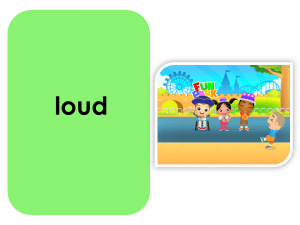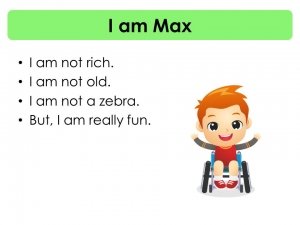
Model all target vocabulary on the student’s communication device. Ask the person to then say each word.
Say one of the adjectives from the word list and ask the person to use their device to name the opposite for each word. If they have trouble, model the correct response and ask them to try again.
Provide a concept word from the target vocabulary list. Ask the person to find opposites of that word around the room. Concept words may include: big, heavy, high, down, etc.
Play a memory game with the Opposite cards. Print out all cards and place them face down in front of the student. Have them turn over a card and use their device to name its opposite. They can then turn over another card and see if it is the correct match. If it is not a match, turn over both cards and try again. One variation is to require the person to use the word in a sentence instead of just naming it’s opposite.
Use the same cards and play Go Fish. Deal out all the cards and have the person use their device to ask for an opposite of a card in their hand. Have them use phrases such as “Do you have _____?” or “Can I have _____?” When you find a set of opposites, you get a point. Play until all the sets are made.

Read the books “Opposites 1” and “Opposites 2” together. The words in each book are ordered by opposite pairs. Before turning the page, ask the person if they can find the opposite for the word. Turn the page and see if they are correct. If they get it wrong, model the correct response and ask them to try again.
Play the Opposite Game with the person. Use dice and markers. Have the person roll one die and move their marker. They can then use their device to tell you the opposite of the word. If they are incorrect, they cannot move their piece. Model the correct response and continue the game.
You can also play a variation of the game by requiring the person to use the opposite word in a sentence before moving forward. Mix it up since you are working on opposites and move the opposite direction on the game board (moving from end to start).

Using magazines or clip art, have the person create their own opposite book. Have them use their device to write a sentence about each picture. Pictures may include opposite pairs such as “happy & sad,” “day & night,” or “big & little.”
Use the included writing template with your student to write the story using computer emulation. Text can be inserted on each line using the AAC device connected to the computer either with a USB cable or a Bluetooth module. When one line is full, the student can tab to the next line. Stories can be printed and illustrations can be added.
If you are using WordPower (Saltillo or TouchChat), save the person’s writing using Stories and Scripts within the vocabulary. Learn more about this feature here.
Give the person the crossword puzzle. Have them use their device to name the opposite for each clue word. If they are able, have them fill in the puzzle. If they are not, have them work with a partner who can fill in the words for them.

Use a magazine to find pictures of facial features. Using these pictures, have the student create two faces, one happy and one sad. Faces should have different eyes, noses, and mouths from a variety of the original faces found. Get creative and see how many opposite faces can be imagined and created!
Give the person the Find a Word puzzle. Have them use their device to tell you the opposite for each word in the list. They can then find the opposite words in the puzzle if they are able. If they cannot circle the words themselves, have them work with a partner to complete the puzzle.
Can-Do Cards are fun, motivational activities the entire family can do to help your child improve their communication skills. Most activities will fit nicely into your daily family routines.
Start Homework Plan
NEXT SECTION
Negative Pronoun + Verb Phrases
Select if you’re proficient at this objective and ready to move onto the next objective
Common Core Standards
Below are references to the Common Core Standards organized by grade level and associated with the goals and objectives of this lesson plan. When considering which standards to target in your lessons with students, begin by looking at the standards at your student’s grade level. You may need to refer to that same standard at a lower grade level to adapt your lesson to best meet the needs of your student.